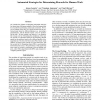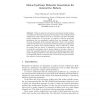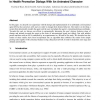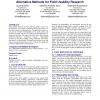611 search results - page 35 / 123 » Using GP to Model Contextual Human Behavior |
AAAI
2012
11 years 10 months ago
2012
We consider the problem of designing automated strategies for interactions with human subjects, where the humans must be rewarded for performing certain tasks of interest. We focu...
IEAAIE
2010
Springer
13 years 5 months ago
2010
Springer
Behavior generation in humans and animals usually employs a combination of bottom-up and top-down patterns. Most available robotic architectures utilize either bottom-up or top-dow...
JBI
2006
13 years 8 months ago
2006
In this paper, we describe our experience with the design and implementation of an embodied conversational agent (ECA) that converses with users in order to change their dietary b...
HUC
2011
Springer
12 years 7 months ago
2011
Springer
Sensor-enabled smartphones are opening a new frontier in the development of mobile sensing applications. The recognition of human activities and context from sensor-data using cla...
SIGDOC
2003
ACM
14 years 1 months ago
2003
ACM
Field usability research involves observing people in their own environments—for example, workplaces, homes, and schools—to learn their normal or natural behavior. Through fie...




